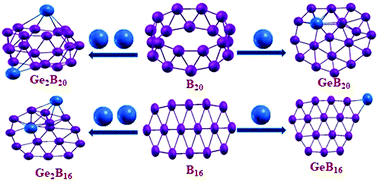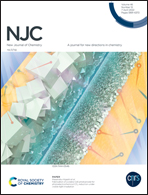Exploring the structure and electronic properties of germanium doped boron clusters using density functional theory based global optimization method†
Abstract
Density functional theory calculations in the framework of B3LYP, TPSS and M06-L were carried out to investigate the effect of single and double germanium atom doping on the geometric structure and electronic properties of boron clusters with 10 to 20 atoms. Global minima of GeBn and Ge2Bn (n = 10–20) were first obtained through Crystal Structure Analysis by the Particle Swarm Optimization method and then subsequently optimized using meta-generalized gradient approximation, hybrid and local functionals. It is found that the lowest energy structures of GeBn and Ge2Bn clusters exhibit planar, quasi-planar, semi-cage, bowl, and double ring topologies. Like BnSi clusters, the results reveal that the germanium atom prefers the peripheral regions of the Bn framework contrary to transition metal doped boron clusters. Furthermore, the calculated electronic properties such as the average binding energy and second order difference in binding energy indicate GeB20 and Ge2B16 to be the most stable clusters. Molecular orbital and adaptive natural density partitioning analyses were carried out to understand the extra stability of GeB20 and Ge2B16 clusters.



 Please wait while we load your content...
Please wait while we load your content...